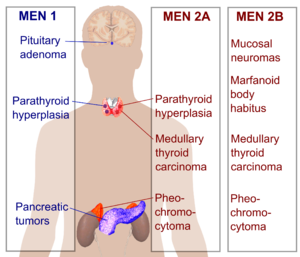Endocrine disease/ja: Difference between revisions
| Line 39: | Line 39: | ||
{{Anchor|List of diseases}} | {{Anchor|List of diseases}} | ||
=== グルコース恒常性障害=== | |||
== | * [[Diabetes/ja|糖尿病]]である。 | ||
* [[Diabetes]] | ** [[Diabetes mellitus type 1/ja|1型糖尿病]] | ||
** [[Diabetes mellitus type 1| | ** [[Diabetes mellitus type 2/ja|2型糖尿病]] | ||
** [[Diabetes mellitus type 2| | ** [[Gestational Diabetes/ja|妊娠糖尿病]] | ||
** [[Gestational Diabetes]] | ** [[Mature Onset Diabetes of the Young/ja|若年発症糖尿病]] | ||
** [[Mature Onset Diabetes of the Young]] | ** 糖尿病性ミオパチー | ||
** | * [[Hypoglycemia/ja|低血糖症]] | ||
* [[Hypoglycemia]] | ** [[Idiopathic hypoglycemia/ja|特発性低血糖症]] | ||
** [[Idiopathic hypoglycemia]] | ** [[Insulinoma/ja|インスリノーマ]] | ||
** [[Insulinoma]] | * [[Glucagonoma/ja|グルカゴノーマ]] | ||
* [[Glucagonoma]] | |||
<div lang="en" dir="ltr" class="mw-content-ltr"> | <div lang="en" dir="ltr" class="mw-content-ltr"> | ||
Revision as of 12:51, 16 February 2024
| 内分泌疾患 | |
|---|---|
| Other names | Endocrinopathy |
 | |
| 主な内分泌腺 (男性 左側, 女性 右側) 1. 松果体 2. 下垂体 3. 甲状腺 4. 胸腺 5. 副腎 6. 膵臓 7. 卵巣 8. 精巣 | |
| Specialty | 内分泌学 |
内分泌疾患とは、内分泌系の疾患である。内分泌疾患に関連する医学の一分野は内分泌学として知られている。
疾患の種類
大まかに言って、内分泌疾患は3つのグループに分けられる:
- 内分泌腺機能低下/分泌低下(ホルモン欠乏につながる
- 内分泌腺機能亢進/分泌過多(ホルモン過剰につながる)
- 内分泌腺の腫瘍(良性または悪性)
内分泌系疾患はしばしば非常に複雑であり、内分泌系にはフィードバック機構が関与しているため、分泌低下と分泌亢進が混在している。例えば、ほとんどの甲状腺機能亢進症は、甲状腺ホルモンの過剰と甲状腺刺激ホルモンの低レベルを伴う。
病気のリスト
グルコース恒常性障害
Thyroid disorders
Calcium homeostasis disorders and Metabolic bone disease
- Parathyroid gland disorders
- Hyperparathyroidism
- Primary hyperparathyroidism
- Secondary hyperparathyroidism
- Tertiary hyperparathyroidism
- Hyperparathyroid myopathy
- Hypoparathyroidism
- Pseudohypoparathyroidism
- Hypoparathyroid myopathy
- Hyperparathyroidism
- Osteoporosis
- Osteitis deformans (Paget's disease of bone)
- Rickets
- Osteomalacia
Pituitary gland disorders
Posterior pituitary
- Diabetes insipidus
- Syndrome of Inappropriate Antidiuretic Hormone (SIADH)
Anterior pituitary
Adrenal gland disorders
Sex hormone disorders
- Disorders of sex development or intersex disorders
- Hypogonadism (Gonadotropin deficiency)
- Inherited (genetic and chromosomal) disorders
- Acquired disorders
- Ovarian failure (also known as Premature Menopause)
- Testicular failure
- Disorders of Puberty
- Menstrual function or fertility disorders
Tumours of the endocrine glands not mentioned elsewhere

See also separate organs
- Autoimmune polyendocrine syndromes
- Incidentaloma - an unexpected finding on diagnostic imaging, often of endocrine glands
Endocrine emergencies
In endocrinology, medical emergencies include diabetic ketoacidosis, hyperosmolar hyperglycemic state, hypoglycemic coma, acute adrenocortical insufficiency, phaeochromocytoma crisis, hypercalcemic crisis, thyroid storm, myxoedema coma and pituitary apoplexy.
Emergencies arising from decompensated pheochromocytomas or parathyroid adenomas are sometimes referred for emergency resection when aggressive medical therapies fail to control the patient's state, however the surgical risks are significant, especially blood pressure lability and the possibility of cardiovascular collapse after resection (due to a brutal drop in respectively catecholamines and calcium, which must be compensated with gradual normalization). It remains debated when emergency surgery is appropriate as opposed to urgent or elective surgery after continued attempts to stabilize the patient, notably in view of newer and more efficient medications and protocols.
See also
References
External links
- Endocrine+system+diseases at the U.S. National Library of Medicine Medical Subject Headings (MeSH)
- MedlinePlus Overview endocrinediseases
| この記事は、クリエイティブ・コモンズ・表示・継承ライセンス3.0のもとで公表されたウィキペディアの項目Endocrine disease/ja(17 October 2023編集記事参照)を素材として二次利用しています。 Lua error in Module:Itemnumber at line 91: attempt to concatenate local 'qid' (a nil value). |